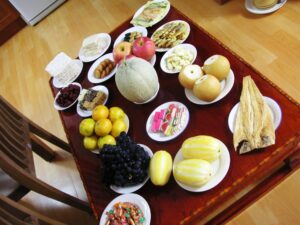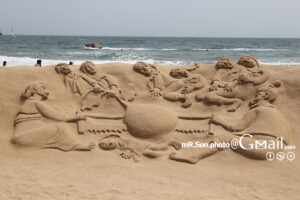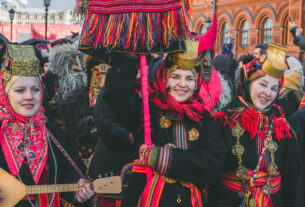South Korea is renowned for its rich tapestry of festivals, each one a vibrant celebration of the nation’s deep-rooted traditions and dynamic cultural heritage. From the bustling streets of Seoul to the tranquil rural landscapes, these festivals offer a captivating glimpse into Korean life, blending ancient customs with contemporary flair. Whether it’s the lively Lunar New Year festivities, the colorful displays of the Chuseok harvest festival, or the playful revelry of the Boryeong Mud Festival, Korean festivals are a feast for the senses and a testament to the country’s joyful spirit.
In this article, we’ll journey through the most iconic Korean festivals, exploring the history, traditions, and unique experiences that make each celebration special. Join us as we delve into the vibrant parades, ceremonial rituals, and festive gatherings that bring Korea’s cultural heritage to life, inviting you to experience the magic and excitement of these remarkable events.
1. Seollal (Lunar New Year)

(commons.wikipedia)
2. Chuseok (Korean Harvest Festival)

(commons.wikipedia)
4. Gwangju Kimchi Festival

(flickr.com)
The Gwangju Kimchi Festival, held annually in Gwangju, South Korea, is a vibrant celebration dedicated to kimchi, a staple of Korean cuisine. Taking place every November, this festival highlights the cultural significance of kimchi and provides an immersive experience for both locals and international visitors. As one of Korea’s most celebrated food festivals, it offers a unique opportunity to delve into the world of kimchi, exploring its rich history, diverse varieties, and essential role in Korean culinary traditions.
Central to the Gwangju Kimchi Festival are the kimchi-making contests, where participants from all walks of life showcase their skills in crafting this iconic dish. Competitors prepare a variety of kimchi types, including traditional napa cabbage kimchi and inventive new flavors. The contests not only celebrate the art of kimchi-making but also serve as a platform for sharing recipes and techniques, fostering a deeper appreciation for this essential Korean food. Judges evaluate the kimchi based on flavor, texture, and presentation, making the contests both a competitive and educational experience.
The festival also features extensive tasting opportunities, allowing visitors to sample an array of kimchi and kimchi-based dishes. From spicy and tangy to milder flavors, the tastings provide a comprehensive overview of the diverse profiles of kimchi. Alongside kimchi, attendees can enjoy dishes that incorporate this versatile ingredient, such as kimchi stew and kimchi pancakes. These tastings offer a chance to experience the rich diversity and complex flavors of kimchi in various culinary contexts.
In addition to food-related activities, the Gwangju Kimchi Festival is a celebration of Korean culture, featuring traditional music, dance performances, and cultural exhibitions. Interactive activities like kimchi-making workshops and cooking classes allow visitors to engage hands-on with Korean culinary traditions. Overall, the festival combines food, culture, and community in a lively and educational atmosphere, underscoring kimchi’s importance in Korean heritage and providing an enriching experience for all attendees.
5. Hwacheon Sancheoneo Ice Festival

(flickr.com)
The Hwacheon Sancheoneo Ice Festival, held annually in January in the scenic town of Hwacheon, South Korea, is a captivating winter event that highlights the region’s natural beauty and local traditions. Central to this vibrant festival is the mountain trout, or sancheoneo, which plays a key role in the festivities. This unique festival offers a range of winter activities set against a picturesque snowy landscape, providing an exciting and memorable experience for visitors of all ages.
One of the festival’s main attractions is ice fishing on the frozen Hwacheon Stream. Participants drill holes into the ice and use traditional fishing methods to catch sancheoneo. This activity is not only a fun and engaging way to experience a classic winter sport but also allows festival-goers to connect with Korea’s fishing heritage. The thrill of catching fish through the ice, combined with the serene winter surroundings, makes ice fishing a highlight of the festival. Additionally, the festival features ice fishing competitions where participants can compete for prizes based on their catches, adding a competitive edge to the experience.
The festival is also renowned for its stunning ice sculptures. Talented artists create intricate and imaginative sculptures from large blocks of ice, showcasing their skill and creativity. These ice sculptures often depict traditional Korean themes as well as whimsical designs, transforming the festival grounds into a dazzling winter wonderland. At night, the illuminated ice sculptures create a magical ambiance, offering visitors a breathtaking visual experience and excellent photo opportunities.
Beyond ice fishing and sculpting, the Hwacheon Sancheoneo Ice Festival includes a variety of other snow-related activities. Visitors can enjoy snow sledding, participate in snowball fights, and even try their hand at ice soccer. These activities add a playful and energetic element to the festival, making it a fun and engaging event for families and friends. Overall, the Hwacheon Sancheoneo Ice Festival celebrates Korea’s winter season with a blend of outdoor adventure, cultural experiences, and festive entertainment, drawing visitors to experience the charm of Hwacheon in the heart of winter.
7. Pansori (Traditional Korean Music)

Pansori is a distinctive genre of Korean traditional music that intricately combines singing with storytelling. Originating in the late 17th century, this art form is renowned for its dramatic and emotional performances that bring to life a variety of historical and folkloric tales. Pansori performances are characterized by their expressive vocal techniques and the ability to convey complex narratives through a blend of music and song. The solo vocalist, known as the sori (singer), plays a central role, delivering both the narrative and emotional depth of the story with great skill and passion.
The performance of pansori is marked by a unique singing style that involves a wide range of vocal techniques. The sori uses dynamic changes in pitch, tempo, and volume to convey different emotions and actions within the story. The singer is typically accompanied by a buk (a large drum) and occasionally other traditional instruments such as the janggu (an hourglass-shaped drum) and the geomungo (a six-stringed zither). The drum provides rhythmic support and enhances the dramatic effect of the performance, helping to drive the narrative and add intensity to key moments.
Pansori performances are deeply rooted in narrative and theatrical expression. Each performance recounts a specific tale or series of events, often exploring themes of love, tragedy, heroism, and social justice. The narrative is presented in a series of madang (acts) that unfold with dramatic pauses, expressive gestures, and powerful vocal delivery. This theatrical approach allows the audience to become fully immersed in the story, experiencing the highs and lows of the narrative through the performer’s expressive portrayal.
The tradition of pansori is also closely tied to the concept of “jeong”, a Korean term that signifies a profound emotional connection and empathy. Pansori’s ability to evoke deep emotions and create a strong bond between performer and audience is a testament to its enduring cultural significance. Through its rich storytelling and musical expression, pansori remains a cherished part of Korean heritage, celebrated for its ability to captivate and connect people through the art of dramatic narration.
8. Boryeong Mud Festival

(flickr.com)
The Boryeong Mud Festival, held annually in Boryeong, South Korea, is a lively and unique celebration that takes place every July at Daecheon Beach. This event, which began in 1998 as a promotional activity for the local mineral-rich mud, has grown into one of Korea’s most popular summer festivals. The festival’s central attraction is its array of mud-related activities, which draw both locals and international tourists eager to experience the fun and playful side of this distinctive celebration.
One of the main highlights of the Boryeong Mud Festival is the mud wrestling competition. Participants compete in a thick, gooey pit of mud, engaging in friendly and often humorous bouts. This event is not only a test of strength and agility but also a source of great entertainment for spectators. The festival also features mudslides, where attendees can race down slick, muddy tracks, and mud baths, offering a relaxing way to immerse oneself in the healthful, mineral-rich mud. These activities create a vibrant and energetic atmosphere, encouraging everyone to embrace the messiness and enjoy the playful spirit of the festival.
In addition to the mud-centric activities, the festival includes a diverse range of cultural performances and music concerts. The stage is graced by both local and international artists, providing a mix of traditional Korean music and contemporary genres. The lively music and dance performances enhance the festive atmosphere, creating a dynamic backdrop to the mud-filled fun. Additionally, the festival features parades and street performances with colorful costumes and engaging dance routines, further adding to the celebratory mood.
The Boryeong Mud Festival also plays a significant role in promoting local tourism and community engagement. It attracts a large number of visitors to Boryeong, boosting the local economy and showcasing the region’s natural beauty and cultural attractions. The festival highlights the health benefits of the mud, which is rich in minerals believed to be beneficial for the skin. Overall, the Boryeong Mud Festival combines interactive activities, cultural events, and community involvement to create an unforgettable and distinctive summer experience.
9. The Seoul Lantern Festival

(flickr.com)
Each November, Seoul’s Cheonggyecheon Stream becomes a luminous canvas of light and creativity during the Seoul Lantern Festival. Since its inception in 2009, this annual event has grown into one of the most celebrated festivals in Korea, drawing crowds from around the world to witness its breathtaking displays. The festival’s centerpiece is a series of elaborate lanterns that line the stream, each meticulously crafted to represent a range of themes from traditional Korean motifs to modern artistic interpretations.
The lanterns, made from hanji (traditional Korean paper) and equipped with LED lights, transform the nighttime scenery into a vibrant spectacle. As visitors stroll along the illuminated pathways, they encounter a captivating array of designs that celebrate Korea’s rich cultural heritage and contemporary artistry. Themes often include historical figures, folklore, and even popular culture icons, each lantern telling its own story through light and color. The contrast between the serene flow of the stream and the vibrant lanterns creates a magical atmosphere that enchants both locals and tourists.
Beyond its visual appeal, the Seoul Lantern Festival offers a range of interactive activities and cultural experiences. Attendees can participate in lantern-making workshops, where they learn to create their own lanterns using traditional techniques. The festival also features live performances, including traditional Korean music and dance, adding to the festive atmosphere and allowing visitors to engage more deeply with Korean culture.
The Seoul Lantern Festival is not just a display of artistic brilliance but also a celebration of community and togetherness. By bringing people from all walks of life to share in the wonder of illuminated art, the festival bridges cultural gaps and fosters a sense of unity. It stands as a testament to Seoul’s ability to blend tradition with modernity, creating an unforgettable experience that highlights the city’s dynamic spirit.
10. Haeundae Sand Festival

(flickr.com)
Every June, Busan’s Haeundae Beach transforms into a dazzling canvas of sand and creativity during the Haeundae Sand Festival. This annual event, celebrated on one of Korea’s most famous beaches, draws visitors from around the world to witness and participate in a unique blend of artistic sand sculptures, engaging beach games, and festive activities. The festival has become a highlight of the summer season, embodying the playful spirit and vibrant energy of the seaside city.
The centerpiece of the Haeundae Sand Festival is the impressive array of sand sculptures created by talented artists from both Korea and abroad. These intricate works of art range from elaborate depictions of mythical creatures and historical figures to imaginative, larger-than-life designs. Sculptors use a mix of sand and water to bring their visions to life, showcasing their skills and creativity. The festival often features a competitive element, with awards given for the most innovative and skillfully crafted sculptures, adding an extra layer of excitement for both participants and spectators.
Beyond the stunning sand sculptures, the festival offers a variety of interactive activities and games that appeal to all ages. Families can enjoy sandcastle-building contests, beach volleyball tournaments, and treasure hunts, creating an atmosphere of fun and camaraderie. The festival also features live music performances, cultural displays, and a wide range of food stalls, enhancing the overall festive experience and providing entertainment for visitors throughout the day.
The Haeundae Sand Festival is more than just an artistic showcase; it’s a celebration of summer, community, and creativity. It brings together people from all walks of life to enjoy the beauty of Busan’s coastline while engaging in a vibrant display of artistic and recreational activities. As the festival continues to grow, it remains a cherished tradition that captures the essence of beachside enjoyment and artistic expression.
Conclusion,
As we wrap up our exploration of Korea’s most enchanting festivals, it’s clear that each celebration is a testament to the country’s rich cultural heritage and vibrant communal spirit. From the exuberant energy of modern festivities to the deep-rooted traditions that honor centuries of history, these festivals offer a unique and immersive experience into Korean life. Whether it’s the joyful reunions of Chuseok, the playful mud-filled antics of Boryeong, or the serene beauty of the Lantern Festival, Korea’s festivals embody a harmonious blend of tradition and contemporary celebration.
These events not only provide an opportunity to experience the rich cultural tapestry of South Korea but also invite people from all corners of the globe to share in the joy and festivity that defines Korean culture. As you reflect on the diverse and captivating festivals we’ve highlighted, you’re invited to embrace the spirit of celebration and discover the magic that makes Korea a truly remarkable place to experience and explore.





